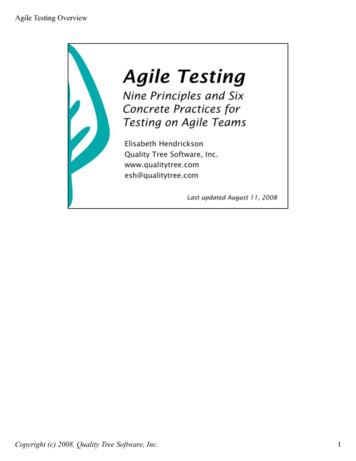
Transcription
Agile Testing OverviewCopyright (c) 2008, Quality Tree Software, Inc.1
Agile Myths, BustedContrary to popular myth, Agile methods are not sloppy, ad hoc, do-whatever-feelsgood processes. Quite the contrary. As Mary Poppendieck points out, speedrequires discipline (see http://www.poppendieck.com/lean-six-sigma.htm). AndExtreme Programming in particular is one of the most disciplined softwaredevelopment processes I’ve ever seen.This means that some of the teams that claim to be doing “Agile” aren’t.Compressing the schedule, throwing out the documentation, and coding up to thelast minute is not Agile: it may result in short term speed but at the cost of long termpain. Agile methods are above all sustainable.Agile teams really do need testers – or at least people who have strong testing skills.But there is a small grain of truth in the idea that Agile teams don’t need QA. That’sbecause Agile teams don’t need is QA acting as a Quality Police. The businessstakeholder – whether the Scrum Product Owner or the XP “Customer” – definewhat’s acceptable and what’s not. The QA or Test group supports the businessstakeholder by helping them clarify acceptance criteria and understand risks.Copyright (c) 2007, Quality Tree Software, Inc.2
Agile Testing OverviewCopyright (c) 2008, Quality Tree Software, Inc.3
Testing Moves the Project ForwardOn traditional projects, testing is usually treated as a quality gate, and the QA/Testgroup often serves as the quality gatekeeper. It’s considered the responsibility oftesting to prevent bad software from going out to the field. The result of thisapproach is long, drawn out bug scrub meetings in which we argue about the priorityof the bugs found in test and whether or not they are sufficiently important and/orsevere to delay a release.On Agile teams, we build the product well from the beginning, using testing toprovide feedback on an ongoing basis about how well the emerging product ismeeting the business needs.This sounds like a small shift, but it has profound implications. The adversarialrelationship that some organizations foster between testers and developers must bereplaced with a spirit of collaboration. It’s a completely different mindset.Version 5.6 Copyright (c) 2007, Quality Tree Software, Inc.4
Testing is NOT a Phase on Agile teams, testing is a way of life.Agile teams test continuously. It’s the only way to be sure that the featuresimplemented during a given iteration or sprint are actually done.Continuous testing is the only way to ensure continuous progress.Copyright (c) 2007, Quality Tree Software, Inc.5
Agile Testing OverviewEveryone TestsOn traditional projects, the independent testers are responsible for all test activities.In Agile, getting the testing done is the responsibility of the whole team. Yes, testersexecute tests. Developers do too.The need to get all testing done in an iteration may mean that the team simplycannot do as much in each sprint as they originally thought. If this is the case, thenAgile has made visible the impedance mismatch between test and dev that alreadyexisted. And that means that the team was not going as fast as they thought. Theyappeared to be going quickly because the developers were going fast. But if thetesting isn't done, then the features aren't done, and the team just does not have thevelocity they think.Another way of thinking about this idea is that testing is the "herbie" on the team(see Goldratt's The Goal). Theory of Constraints says that the whole team can onlygo as fast as the slowest part. To go faster, the team has to widen the throughput ofthe slowest part of the process. Eliminate the bottleneck; everyone tests.Copyright (c) 2008, Quality Tree Software, Inc.6
Agile Testing OverviewShortening Feedback LoopsHow long does the team have to wait for information about how the software isbehaving? Measure the time between when a programmer writes a line of code andwhen someone or something executes that code and provides information about howit behaves. That’s a feedback loop.If the software isn’t tested until the very end of a long release, the feedback loopswill be extended and can be measured in months. That’s too long.Shorter feedback loops increase Agility. Fortunately, on Agile projects the softwareis ready to test almost from the beginning. And Agile teams typically employseveral levels of testing to uncover different types of information.Automated unit tests check the behavior of individual functions/methods and objectinteractions. They’re run often, and provide feedback in minutes. Automatedacceptance tests usually check the behavior of the system end-to-end. (Although,sometimes they bypass the GUI, checking the underlying business logic.) They’retypically run on checked in code on an ongoing basis, providing feedback in an houror so. Agile projects favor automated tests because of the rapid feedback theyprovide.Manual regression tests take longer to execute and, because a human must beavailable, may not begin immediately. Feedback time increases to days or weeks.Manual testing, particularly manual exploratory testing, is still important. However,Agile teams typically find that the fast feedback afforded by automated regression isa key to detecting problems quickly, thus reducing risk and rework.Copyright (c) 2008, Quality Tree Software, Inc.7
So Where Do Those Expectations Come From?Once upon a time, before I started working on XP projects, I worked on a projectwhere the developer protested “SCOPE CREEP!” to every bug report I filed.Sadly, the two of us built up a lot of animosity arguing over whether or not the bugsI found were bugs or enhancements. I reasoned that I was testing conditions thatwere likely to occur in the real world, and “not crashing” did not count as anenhancement. The programmer argued that he’d done what he’d been asked to doand that it was too late to add more work to his plate. “No one said anything aboutthe software being able to handle corrupt data!” he snapped.I realized that the programmer thought I was making up new requirements as I wentalong.Of course, that’s not what I intended. The way I saw it, my testing was revealinganswers to questions no one had thought to ask before: What if this file is locked?What if that connection is broken? What if the data is corrupted? I would have askedthe questions earlier if I could, but this was a waterfall-ish project, and testinghappened at the very end of the process.Working with XP teams has taught me that every test, whether manual or automated,scripted or exploratory, represents a bundle of expectations. Like the file tests I ranon that early project, sometimes those expectations represent implicit requirements(like “don’t crash”). But sometimes my expectations turn out to be unreasonable.So now, before I spend a huge amount of time testing for a given type of risk, I askquestions to clarify my expectations with the project stakeholders.Version 5.6 Copyright (c) 2007, Quality Tree Software, Inc.8
Agile Testing OverviewKeep the Code CleanThis principle is an example of the discipline that Agile teams have. It takestremendous internal discipline to fix bugs as they are found. If it’s a genuine bug, asopposed to a new story, it is fixed within the iteration. To do otherwise is likecooking in a filthy kitchen: it takes longer to wade through the mess to do thecooking, and the resulting food may or may not be edible.Copyright (c) 2008, Quality Tree Software, Inc.9
Agile Testing OverviewLightweight DocumentationInstead of writing verbose, comprehensive test documentation, Agile testers: ! Use reusable checklists to suggest tests ! Focus on the essence of the test rather than the incidental details ! Use lightweight documentation styles/tools ! Capturing test ideas in charters for Exploratory Testing ! Leverage documents for multiple purposeLeveraging One Test Artifact for Manual and Automated TestsRather than investing in extensive, heavyweight step-by-step manual test scripts inWord or a test management tool, we capture expectations in a format supported byautomated test frameworks like FIT/Fitnesse. The test could be executed manually,but more importantly that same test artifact becomes an automated test when theprogrammers write a fixture to connect the test to the software under test.Copyright (c) 2008, Quality Tree Software, Inc.10
Agile Testing Overview“Done Done,” Not Just DoneIn traditional environments that have a strict division between development and test,it is typical for the developers to say they are “done” with a feature when they haveimplemented it, but before it is tested.Of course the feature isn’t “done” until it’s been tested and any bugs have beenfixed. That’s why there’s a long standing joke in the industry that a given softwarerelease is usually “90% done” for 90% of the project. (Or, in other words, the last10% of the effort takes 90% of the time.)Agile teams don’t count something as “done,” and ready to be accepted by theProduct Owner or Customer until it has been implemented and tested.Copyright (c) 2008, Quality Tree Software, Inc.11
Test-Last v. Test-DrivenIn traditional environments, tests are derived from project artifacts such asrequirements documents. The requirements and design come first, and the testsfollow. And executing those tests happens at the end of the project. This is a “testlast” approach.However, tests provide concrete examples of what it means for the emergingsoftware to meet the requirements. Defining the tests with the requirements, ratherthan after, and using those tests to drive the development effort, gives us much moreclear done criteria and shared focus on the goal. This test-first approach can be seenin the TDD and ATDD practices (see later slides).Copyright (c) 2007, Quality Tree Software, Inc.12
Agile Testing OverviewCopyright (c) 2008, Quality Tree Software, Inc.13
Agile Testing OverviewCopyright (c) 2008, Quality Tree Software, Inc.14
Copyright (c) 2007, Quality Tree Software, Inc.15
Agile Testing OverviewCopyright (c) 2008, Quality Tree Software, Inc.16
The ATDD Cycle!Discuss: work with the business stakeholders to understand their realneeds and concerns. In traditional environments, this is usually called“requirements elicitation.” In the context of Agile development, thepurpose of this discussion is not to gather a huge list of requirements butrather to understand what the business stakeholder needs from oneparticular feature. During these discussions, ask questions designed touncover assumptions, understand expectations around non-functionalneeds such as stability, reliability, security, etc., and explore the full scopeof work the business stakeholder is requesting.!Distill: collaborate with the business stakeholders to distill their statedneeds into a set of acceptance tests, or examples, that define “done.”These tests should focus on externally detectable behavior and will beexpressed in tables or keywords.!Develop: write the code to implement the requested feature using testdriven development (TDD). !Demonstrate: show the business stakeholder the new feature in theemerging system and request feedback. !Copyright (c) 2007, Quality Tree Software, Inc.17
A Short History of Exploratory TestingCem Kaner coined the term “Exploratory Testing” in his book Testing ComputerSoftware, although the practice of Exploratory Testing certainly predates the book.Since the book’s publication two decades ago, Cem Kaner, James Bach, and a groupof others (including Elisabeth Hendrickson and James Lyndsay) have worked toarticulate just what Exploratory Testing is and how to do it.Exploratory Testing Can Be RigorousTwo key things distinguish good Exploratory Testing as a disciplined form oftesting: ! Using a wide variety of analysis/testing techniques to target vulnerabilitiesfrom multiple perspectives. ! Using charters to focus effort on those vulnerabilities that are of most interestto stakeholders.Version 5.6 Copyright (c) 2007, Quality Tree Software, Inc.18
Agile Testing OverviewCopyright (c) 2008, Quality Tree Software, Inc.19
Agile Testing OverviewCollaborative TestingEven before I started working with XP teams, I felt that it is important for testers tocollaborate with all the other project stakeholders. In the course of my years in thisindustry, I have observed that isolation usually leads to duplicated and wasted effort.Working on XP teams confirmed my beliefs. By integrating testing anddevelopment, we produced more solid code, more quickly, than I had seen on any ofmy past projects. Certainly there are contexts where independent testing is required,such as with safety-critical systems. But that doesn’t mean the independent testersshould be the only ones testing.In XP, testing isn’t a phase but rather a way of working so that at any given point ina project, you know that the work done to date meets the expectations stakeholdershave of that work. And that requires a whole team effort.Copyright (c) 2007 Quality Tree Software, Inc.20
Agile Testing OverviewCopyright (c) 2008, Quality Tree Software, Inc.21
Cem Kaner coined the term “Exploratory Testing” in his book Testing Computer Software, although the practice of Exploratory Testing certainly predates the book. Since the book’s publication two decades ago, Cem Kaner, James Bach, and a group of others (includin










